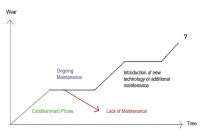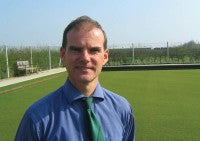Wear today... gone tomorrow
Before we can give suggestions for improved maintenance we need to identify the issues surrounding pitch wear.
 Apart from the agronomic composition, the key factors that will determine the level of wear a pitch can cope with, before significant grass loss occurs, are the soil type and drainage.
Apart from the agronomic composition, the key factors that will determine the level of wear a pitch can cope with, before significant grass loss occurs, are the soil type and drainage.
A sandy soil will generally be able to cope with a higher level of play than a clay soil. It is very difficult to predict this level but, in the past, Sport England have indicated up to two hours adult play per week on an undrained clay pitch, rising to six hours for a fully drained or sandy pitch.
Whatever the make-up of a pitch, try and avoid use if the top 30mm is saturated or very wet - this is when the real damage is done. Groundsmen often talk about their pitch problems developing after a specific game played in atrocious conditions, after which it was an ongoing problem to present and sustain decent surfaces.
Maintenance is also a key factor, influencing the ability of a pitch to cope with wear. If the maintenance of a heavy soil only consists of marking out and cutting, you can expect problems.
The graph tries to demonstrate this. It shows that, from establishment, the level of wear a pitch will cope with is related to the level of maintenance provided. Maintenance could then remain constant or, as often occurs, decline as increased play occurs. The only way to hopefully reduce wear is to increase or change maintenance. There will, however, be limits regarding finance, opportunity or just excess play that prevent further improvements.
What's wrong with the pitch?
T o answer this question we need to know the soil type, maintenance and factors associated with wear.
o answer this question we need to know the soil type, maintenance and factors associated with wear.
On heavier soils, if a pitch is wet with poor drainage then the contributory reasons need to be identified. Most common is that any installed drainage is either malfunctioning or is not sufficient to cope with the demands placed on it.
On an undrained pitch the first option, if the soils are very heavy, is to intensively drain the pitch. In terms of maintenance, the first stage to improve the situation is to develop an aeration and decompaction programme. The "Verti-Drain" is an important way of increasing percolation rates. Such deep aeration treatment could be undertaken up to four times per year with other aeration also carried out frequently.
In conjunction with aeration it is hugely beneficial to give sand dressings. The spring renovation period is a key time for incorporating sand into heavy soils, but make sure that amelioration is achieved through the top 100-150mm and not allowed to form a thick sand layer on the surface.
Sand selection is important and the use of a suitable medium-fine sand is vital. The use of lower quality sands can often worsen the situation. Sand is expensive but, if applied over a number of years, can transform a pitch. Typically, 50-80 tonnes of sand would be applied to a pitch. At 80 tonnes this equates to a layer around 5-7mm thick! If cost is an issue then the central portion of a pitch could be dressed as this is normally the worst part. In-season local light dressings of sand to any wet patches can keep a pitch playable.
Another important aspect is the nature of pitch usage. From our experience the greatest damage to a pitch is often caused by training activity, I typically equate one hours training to two hours normal play in terms of wear. This is due to repeated exercise and the concentration of activity.
The use of training grids to take training off the pitch and mobile goals to prevent penalty and goalkeeping practice off the penalty box are a couple of ideas easy to introduce. The pitch should be reserved for practice and formal matches.
The intensity of play is a factor; very few grass surfaces will cope with 10-15 hours + play per week without massive loss of grass and surface disruption. But, pitches can cope with surprising levels of wear and it is up to those responsible for maintenance to determine what is achievable. In some cases additional facilities will be necessary or, alternatively, restrictions on pitch use.
Where younger children are the main users there is often less damage from play. Certainly, records of play should be gathered so maintenance decisions can be made with this information.
What's next?
Once the basics of aeration and appropriate usage have been tackled then the end of season maintenance needs to be addressed. This should involve vertidraining and sand dressing. In addition, most pitches would benefit from overseeding and fertilisation. The seed, typically, would contain three or four cultivars of ryegrass, occasionally smooth-stalked meadow-grass and perhaps some fescue. The seed could be introduced in two directions at a rate dependent on live grass cover. Weeds may also need to be treated.
Bare goalmouths would benefit from cultivation, sand amelioration and seeding and then protected from play. The goal posts should be removed to prevent casual play.
In a dry spring and summer some irrigation would be ideal, especially on a sandier soil.
Fertiliser is vital in the promotion of a healthy sward capable of withstanding play. Heavier soils often require one to two applications of general-purpose, conventional release fertilisers per year, whereas sandier soils can require monthly dressings or the use of controlled release fertiliser. It is difficult to be specific without a soil analysis or knowledge of a site.
Good cutting regimes help to maximise grass density. The grass should be cut when needed rather than to a time-based specification. Allowing grass to grow long weakens the plant and, if then closely cut, leaves debris on the surface that smothers the sward below. You should never remove more than 30% of the length when mowing
 The use of growth regulators is becoming more common. The modern formulations discourage vertical growth and encourage a more compact, dense sward, thus reducing mowing frequency, but without affecting sward performance and ability to withstand wear.
The use of growth regulators is becoming more common. The modern formulations discourage vertical growth and encourage a more compact, dense sward, thus reducing mowing frequency, but without affecting sward performance and ability to withstand wear.
In summary - what would I do?
Initially, I would ensure usage of the surface was not causing unnecessary wear. I would limit training to grids and off pitch areas. I would try to ensure communication with the games staff, including them in what conditions the pitch should not be played, and even get them involved in monitoring pitch usage.
Next, I would ensure the aeration, decompaction, sand dressings, renovation fertiliser elements matched the soil and surface.
Finally, I would look at the need for further drainage, from primary pipe systems to secondary systems. But that's another story...
Steve Gingell
